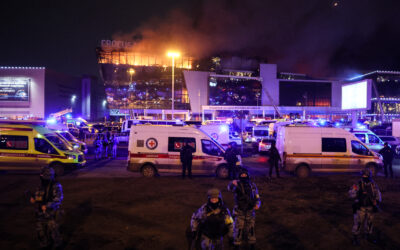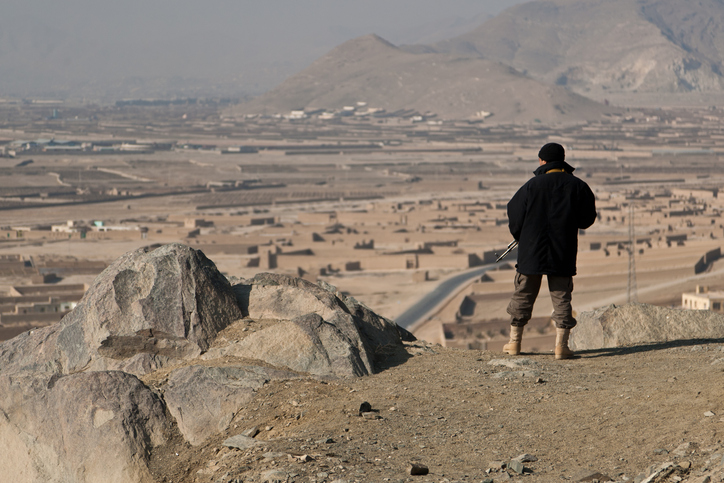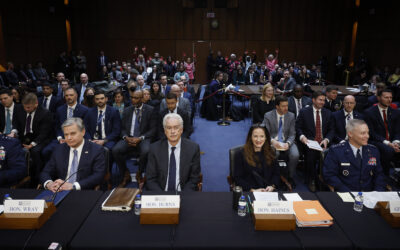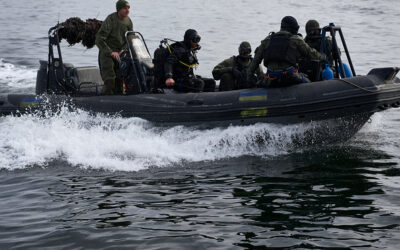
Assessing the ISIS-K Threat: Could It Happen Here?
SUBSCRIBER+ EXCLUSIVE ANALYSIS – For months, U.S. officials have sounded vague but ominous alarms about the threat of terrorism in the U.S. – most noteworthy, […] More

A United Nations report delivered to the Security Council last month offered a stark reminder that al Qaeda remains a serious threat around the world. The report suggested that the de-centralized terrorist network is stronger than ISIS in countries like Yemen and Somalia.
The report was issued just before al Qaeda leader Ayman al Zawahiri released a new video calling on Muslims to unite against what he calls an “international infidel alliance”.
U.S. Ambassador to the United Nations Nikki Haley said last week that we “cannot forget the enduring threat posed by al-Qaeda. ISIS may have captured more headlines in recent years, but al-Qaeda leaders are still plotting attacks around the world. This includes a large remaining al-Qaeda presence in Syria, Yemen, and other parts of the world.”
The Cipher Brief tapped its network of experts to better understand the breadth and depth of the al-Qaeda threat, some 17 years after 9/11.
Bottom Line: While the actions of the Islamic State (ISIS) have dominated headlines over the past few years due to the organization’s brutal tactics and ability to capture and sometimes hold, territory across the Middle East, al-Qaeda has quietly rooted itself in several conflicts across Africa, the Middle East and South Asia, where it has seized upon local grievances to appeal to disenfranchised communities and build its brand as a champion of victimized Sunnis. Consequently, al-Qaeda’s strategy, combined with its long-term vision, renders the movement the most dangerous and entrenched terrorist network devoted to carrying out attacks against the West, and the United States in particular.
Background: Al-Qaeda, meaning “the base,” was established in 1988 in the Pakistani city of Peshawar close to the Afghan border under the guidance of Osama bin-Laden, prominent Palestinian cleric Abdullah Azzam, current leader Ayman al-Zawahiri and several hardline mujahedeen rebels who had fought against the Soviet Union during its invasion of Afghanistan in the 1980s.
David Shedd, Former Acting Director, Defense Intelligence Agency

“Locations such as Libya, Egypt, Somalia, Yemen, Syria and Iraq remain attractive territory from which to draw Sunni recruits while targets for terrorist attacks in Europe, and if at all possible, inside the United States, remain highly attractive.”
Issue: Despite years of targeted strikes and raids by the U.S. military and its allies that have decimated core al-Qaeda in Afghanistan and Pakistan, the movement continues to pose a critical threat to U.S. security at home and America’s interests abroad. Al-Qaeda affiliates have enmeshed themselves in ongoing civil conflicts in the Sahel, Somalia, Syria, Yemen and South Asia, where they have garnered support from local communities and have carved out safe havens from which to train, plan and launch attacks.
Admiral James ‘Sandy’ Winnefeld, Former Vice Chairman, Joint Chiefs of Staff

“My sense is that the al Qaeda brand is severely tarnished within the Muslim world. Nothing succeeds like success. Al Qaeda’s stock soared in the wake of 9/11 when they conducted a highly credible, game-changing attack on a vulnerable enemy, and became public enemy number one. However, now that they have been seriously beaten down, their message coming from South Asia seems shrill and tinny. Ayman al-Zawahiri has little gas left in the tank, and I’ve not seen evidence of a charismatic leader emerging in his wake.”
Mitch Silber, Former Director of Analysis, NYPD

“As recent reporting from Afghanistan has documented, the U.S. is no longer really fighting al-Qaeda there, leaving the question open as to where are its central leadership — where is al-Zawahiri and where is Hamza bin-Laden, the heir apparent to the organization and maybe even more importantly — what is the nature of the cadre of followers that surround them? Can they mobilize followers and operatives to conduct deadly attacks globally? The absence of significant al-Qaeda led attacks out of regional theaters calls into question what command structure surrounds al-Zawahiri and Hamza bin Laden.”
Al-Qaeda’s Syrian offshoot, formerly known as Jabhat al-Nusra or the al-Nusra Front, emerged in January 2012 against the backdrop of the Syrian civil war and has strategically positioned itself as the largest rebel force battling the regime of Syrian President Bashar al-Assad. Jabhat al-Nusra served as al-Qaeda’s overt Syrian affiliate until July 2016, when leader Abu Muhammad al-Joulani announced that his group was “splitting” from the al-Qaeda network and rebranding itself as Jabhat Fateh el-Sham or JFS. However, there was significant skepticism that a real separation had occurred. In January 2017, JFS merged with four smaller Syrian jihadist factions to form an umbrella organization called Hayat Tahrir al-Sham (HTS), an estimated force of at least 10,000 fighters that now dominates approximately two million people living in Syria’s northwestern Idlib province.
John Bennett, Former Director, CIA National Clandestine Service

“AQ continues to control space in Yemen and could rebuild if allowed to once again establish a safe haven in Afghanistan. There may be a viable pool of recruits from those who responded to ISIS’ call to arms in Syria/Iraq, but who have become disillusioned with ISIS’ brutal rule of fellow Muslims. ISIS’ more conventional approach to armed conflict with Western powers and Iran has also proven ineffective. Former ISIS fighters returning home to Europe or elsewhere in the Middle East or Asia could be recruited into the existing AQ networks to conduct more “traditional” terrorist operations.”
It remains critical to continue to deny AQ safe havens to rebuild their operational cadre and to disrupt their network infrastructure where it still exists in the West and Arab world. This has been a long fight but we face a very resilient enemy.
Admiral James ‘Sandy’ Winnefeld, Former Vice Chairman, Joint Chiefs of Staff

“Their strength in Saudi Arabia has been suppressed, and was never really a factor in the Emirates and other nations on the Peninsula. Al Qaeda is slowly being choked as a sideshow in the war in Yemen. It retains some strength in Syria, but has never really been a major player there, and any remnants are about to be crushed by the combined Syrian/Russian offensive around Idlib. Their affiliate in Somalia is a local force, but not a major threat to the West.”
Response: U.S. intelligence agencies and law enforcement have worked to capture or kill leading figures of the al-Qaeda movement and ensure that a repeat of 9/11 does not occur on American soil. However, to truly realize the defeat of al-Qaeda, American policymakers may need to go back to the drawing board and reassess how the al-Qaeda threat should be understood.
Looking Ahead: The ongoing battle against al-Qaeda has honed the United States’ ability to identify and eliminate terrorist leaders, and has also generated increased cooperation among U.S. law enforcement and intelligence to head off potential 9/11-style attacks. But as long as poor governance and instability provides a breeding ground for radical ideology, terrorism will pose a generational challenge.
Mitch Silber, Former Director of Analysis, NYPD

“The most important issue for policy makers and CT professionals is not to be lulled into complacency because of the strong gains that have been made degrading the Islamic State. During the period of 2012-2014, when many administration officials were applauding the “end of al Qaeda”, was precisely the period when the Islamic State was building up its infrastructure and capabilities to burst onto the scene and surprise intelligence analysts, CT professionals and policy makers. The question is not if, but what is the next ungoverned area that serves as a”field of jihad” that will attract willing acolytes from the West and around the world and how can it be smothered early.”
David Shedd, Former Acting Director, Defense Intelligence Agency

“We need to keep in mind that al Qaeda and its like-minded extremists see their struggle against the infidels as multi-generational and very long term. While facing setbacks, they have accounted for those setbacks in their struggle. Al Qaeda’s ability to recruit new talent is not waning even if their operational space for training and executing their attacks is more challenging today than nearly two decades ago. We must never ever forget that we face a determined enemy intent on “winning the long war.”
Related Articles

SUBSCRIBER+ EXCLUSIVE ANALYSIS – For months, U.S. officials have sounded vague but ominous alarms about the threat of terrorism in the U.S. – most noteworthy, […] More

OPINION / EXPERT PERSPECTIVE — On the night of March 22, four masked individuals armed with automatic weapons entered the Crocus City Hall in the […] More

OPINION / EXPERT PERSPECTIVE – The death toll from last week’s terrorist attack inside a concert hall in a suburban Moscow neighborhood is now at […] More

SUBSCRIBER+EXCLUSIVE REPORTING — The nation’s top intelligence agencies delivered a sobering threat assessment Monday, focused on spillover dangers posed by the wars in Ukraine and […] More

SUBSCRIBER+ EXCLUSIVE ANALYSIS – From the Middle East to Russia’s war on Ukraine, cybersecurity to disinformation to the emergence of an axis of powers – […] More

Subscriber+Exclusive Interview — In his new book, By All Means Available: Memoirs of a Life in Intelligence, Special Operations, and Strategy, former Undersecretary of Defense for Intelligence […] More
Search